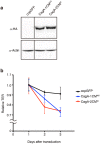Impact of structural polymorphism for the Helicobacter pylori CagA oncoprotein on binding to polarity-regulating kinase PAR1b
- PMID: 27445265
- PMCID: PMC4957108
- DOI: 10.1038/srep30031
Impact of structural polymorphism for the Helicobacter pylori CagA oncoprotein on binding to polarity-regulating kinase PAR1b
Abstract
Chronic infection with cagA-positive Helicobacter pylori is the strongest risk factor for atrophic gastritis, peptic ulcers, and gastric cancer. CagA, the product of the cagA gene, is a bacterial oncoprotein, which, upon delivery into gastric epithelial cells, binds to and inhibits the polarity-regulating kinase, partitioning-defective 1b (PAR1b) [also known as microtubule affinity-regulating kinase 2 (MARK2)], via its CagA multimerization (CM) motif. The inhibition of PAR1b elicits junctional and polarity defects, rendering cells susceptible to oncogenesis. Notably, the polymorphism in the CM motif has been identified among geographic variants of CagA, differing in either the copy number or the sequence composition. In this study, through quantitative analysis of the complex formation between CagA and PAR1b, we found that several CagA species have acquired elevated PAR1b-binding activity via duplication of the CM motifs, while others have lost their PAR1b-binding activity. We also found that strength of CagA-PAR1b interaction was proportional to the degrees of stress fiber formation and tight junctional disruption by CagA in gastric epithelial cells. These results indicate that the CM polymorphism is a determinant for the magnitude of CagA-mediated deregulation of the cytoskeletal system and thereby possibly affects disease outcome of cagA-positive H. pylori infection, including gastric cancer.
Figures






Similar articles
-
Evaluating the origin and virulence of a Helicobacter pylori cagA-positive strain isolated from a non-human primate.Sci Rep. 2018 Oct 29;8(1):15981. doi: 10.1038/s41598-018-34425-4. Sci Rep. 2018. PMID: 30374120 Free PMC article.
-
Sequence Polymorphism and Intrinsic Structural Disorder as Related to Pathobiological Performance of the Helicobacter pylori CagA Oncoprotein.Toxins (Basel). 2017 Apr 13;9(4):136. doi: 10.3390/toxins9040136. Toxins (Basel). 2017. PMID: 28406453 Free PMC article. Review.
-
Structural and functional diversity in the PAR1b/MARK2-binding region of Helicobacter pylori CagA.Cancer Sci. 2008 Oct;99(10):2004-11. doi: 10.1111/j.1349-7006.2008.00950.x. Cancer Sci. 2008. PMID: 19016760 Free PMC article.
-
Natural variant of the Helicobacter pylori CagA oncoprotein that lost the ability to interact with PAR1.Cancer Sci. 2014 Mar;105(3):245-51. doi: 10.1111/cas.12342. Epub 2014 Feb 12. Cancer Sci. 2014. PMID: 24354359 Free PMC article.
-
Helicobacter pylori and gastric carcinogenesis.J Gastroenterol. 2009;44(4):239-48. doi: 10.1007/s00535-009-0014-1. Epub 2009 Mar 7. J Gastroenterol. 2009. PMID: 19271114 Review.
Cited by
-
Evaluating the origin and virulence of a Helicobacter pylori cagA-positive strain isolated from a non-human primate.Sci Rep. 2018 Oct 29;8(1):15981. doi: 10.1038/s41598-018-34425-4. Sci Rep. 2018. PMID: 30374120 Free PMC article.
-
Kinase Activity of PAR1b, Which Mediates Nuclear Translocation of the BRCA1 Tumor Suppressor, Is Potentiated by Nucleic Acid-Mediated PAR1b Multimerization.Int J Mol Sci. 2022 Jun 14;23(12):6634. doi: 10.3390/ijms23126634. Int J Mol Sci. 2022. PMID: 35743080 Free PMC article.
-
Creation and Initial Characterization of Isogenic Helicobacter pylori CagA EPIYA Variants Reveals Differential Activation of Host Cell Signaling Pathways.Sci Rep. 2017 Sep 8;7(1):11057. doi: 10.1038/s41598-017-11382-y. Sci Rep. 2017. PMID: 28887533 Free PMC article.
-
Sequence Polymorphism and Intrinsic Structural Disorder as Related to Pathobiological Performance of the Helicobacter pylori CagA Oncoprotein.Toxins (Basel). 2017 Apr 13;9(4):136. doi: 10.3390/toxins9040136. Toxins (Basel). 2017. PMID: 28406453 Free PMC article. Review.
-
Structure and function of Helicobacter pylori CagA, the first-identified bacterial protein involved in human cancer.Proc Jpn Acad Ser B Phys Biol Sci. 2017;93(4):196-219. doi: 10.2183/pjab.93.013. Proc Jpn Acad Ser B Phys Biol Sci. 2017. PMID: 28413197 Free PMC article. Review.
References
-
- Peek R. M. & Blaser M. J. Helicobacter pylori and gastrointestinal tract adenocarcinomas. Nat. Rev. Cancer 2, 28–37 (2002). - PubMed
-
- Hatakeyama M. Helicobacter pylori CagA and gastric cancer: A paradigm for hit-and-run carcinogenesis. Cell Host Microbe 15, 306–316 (2014). - PubMed
-
- Nomura A. et al.. Helicobacter pylori infection and gastric carcinoma among Japanese Americans in Hawaii. N. Engl. J. Med. 325, 1132–1136 (1991). - PubMed
-
- Parsonnet J. et al.. Helicobacter pylori infection and the risk of gastric carcinoma. N. Engl. J. Med. 325, 1127–1131 (1991). - PubMed
-
- Ferlay J. et al.. Cancer incidence and mortality worldwide: Sources, methods and major patterns in GLOBOCAN 2012. Int. J. Cancer 136, E359–E386 (2015). - PubMed
Publication types
MeSH terms
Substances
LinkOut - more resources
Full Text Sources
Other Literature Sources

